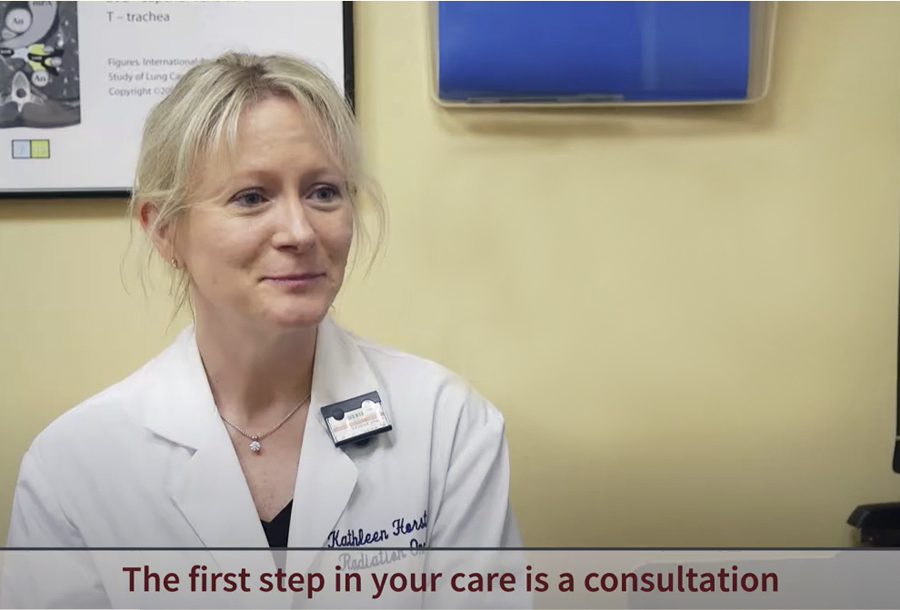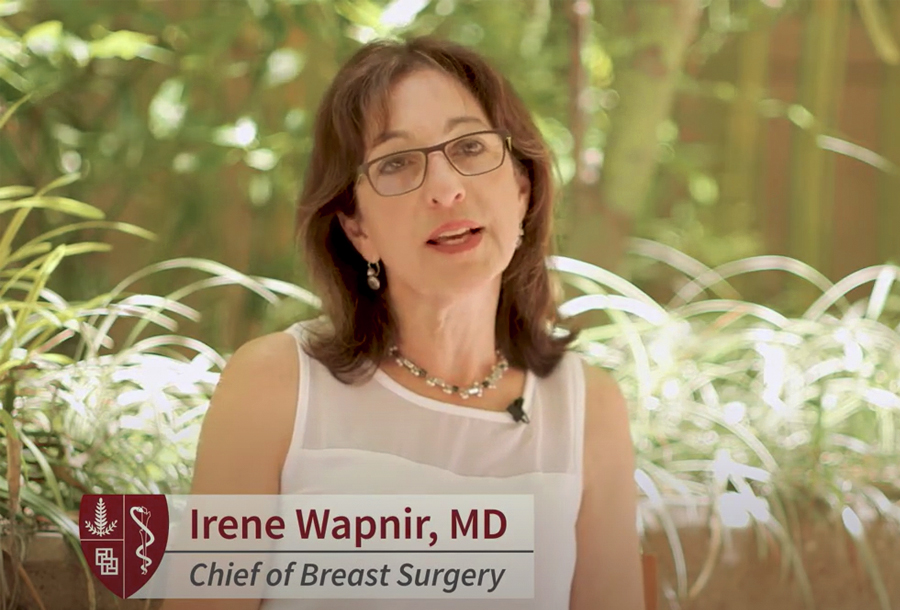At Stanford Health Care, we offer you the most advanced diagnosis and treatment techniques for breast cancer, no matter how common or complex the type. Our center is a major referral center for women and men across the country with breast cancer.
Overview
What is breast cancer?
The breast is made up of a system of lobes (separate parts) and branching tubes that exit at the nipple. Breast cancer develops in the tissues that make up this system. It has many different forms, each with different behavior and treatments.
In general, cancer develops after the genetic material in cells changes and the cells grow out of control. When there are enough of these abnormal cells, they form a tumor that is visible on a mammogram or felt as a lump during a breast exam.
Not all tumors in the breast are cancerous. A biopsy can help your doctor evaluate a tumor that looks suspicious.
How does breast cancer develop?
Many patients wonder why they developed breast cancer or if they are at a high risk for the disease.
Most breast cancers result from the accumulation of random mutations, or mistakes, in genes. Because these mutations increase over time, your risk of developing cancer also increases as you get older.
Only about 5% to 10% of breast cancers are linked to inherited genetic mutations such as BRCA1 and BRCA2. These mutations make it difficult for cells to fix the random mutations that occur over time. Patients who have an inherited mutation are at a much higher risk of developing breast cancer, often at a younger age than the average woman.
Connect to Care
Let us help find personalized care options for you and your family.
Understanding Breast Cancer
Symptoms of Breast Cancer
While screening mammograms detect most breast cancers, self-detection plays an important role in recognizing breast cancer early. Signs and symptoms of breast cancer you can watch out for include:
- A lump or irregular area of firmness
- A lump under the arm, along or above the collarbone, or at your neck
- Changes such as retraction or dimpling in the breast skin, nipple, or areola
- Nipple discharge or bleeding
- Nipple inversion, where the nipple flattens or points inward instead of outward
- Skin inflammation or redness that does not go away
Breast Cancer Risk Factors
Some risk factors for breast cancer fall within your control, while others do not. Having one or more of these factors does not necessarily mean that you will develop breast cancer. Most people who develop the disease have minimal risk factors.
Breast cancer risk factors include:
- Age: Breast cancer risk increases with age, especially in women over 50.
- Gender: Women are much more likely to develop breast cancer than men.
- Breast density: Dense breast tissue makes it harder to detect cancer on mammograms.
- Ethnicity: Women of Ashkenazi Jewish heritage are more likely to have an inherited BRCA gene mutation.
- Exposure to radiation: Radiation exposure to the chest from childhood through early adulthood increases breast cancer risk.
- Family history: Breast cancer risk increases if you have a close relative who had breast cancer.
- History of breast or ovarian cancer: Having cancer in one breast slightly increases the risk of developing a second separate breast cancer. Women with ovarian cancer associated with BRCA1 or BRCA2 genetic mutation have an increased risk of breast cancer.
- Hormone replacement therapy: Taking hormone replacement therapy after menopause increases the risk of developing breast cancer.
- Inherited genetic predisposition: Having specific hereditary genetic mutations, such as a BRCA1 or BRCA2 mutation, increases your risk.
- Lifestyle factors: Factors such as lack of physical activity and overconsumption of alcohol can increase the risk of breast cancer.
- Menstrual history: Women whose periods began before age 12 or who experienced menopause after age 55 are at a higher risk for breast cancer.
- Reproductive history: Women who gave birth to their first child after 30 or have never been pregnant have an increased risk of breast cancer.
Types of Breast Cancer
Breast cancer types are often named for where they start in the breast. Several types of breast cancer exist, including:
- Invasive ductal carcinoma makes up about 80% of all breast cancers. It invades the breast ducts and may spread nearby or to distant parts of the body.
- Invasive lobular carcinoma invades throughout the lobule system of the breast and has the potential to spread nearby or to other parts of the body.
- Invasive inflammatory breast cancer spreads in the breast and skin lymph vessels, causing blockage that leads to fluid buildup. As a result, the skin appears red, dimpled, and swollen
- Invasive metastatic breast cancer means the cancer has spread to other parts of the body. This advanced form of breast cancer is treatable but most often not curable.
- Noninvasive ductal carcinoma (also known as ductal carcinoma in situ) develops only within the milk ducts. If left untreated, it likely evolves into invasive ductal cancer.
- Noninvasive lobular carcinoma (also known as lobular carcinoma in situ) begins in the lobes and increases the risk of developing other breast cancers.
Biological Factors
Invasive breast cancer is characterized based on additional pathology findings. Some of these pathology findings include:
- Cell type (histologic type): This feature is based on the growth pattern of the cancer under the microscope. The vast majority (approximately 80%) of breast cancers are a ductal histologic subtype. About 5-10% of breast cancers are lobular. Lobular cancers are less likely to form a distinct mass and their extent may be harder to identify on mammography. There are other less common special histologic types, like mucinous and tubular carcinomas, that have a particularly slow growth and good prognosis.
- Grade: This feature describes how like or unlike normal tissue the cancer is. A higher grade means it is more aggressive and fast growing, with features that are less like normal breast tissue. A lower grade is usually associated with slower growth. One method of determining grade is the Nottingham system, with a range of grades from 1 (low), to 2 (intermediate) to 3 (high).
- Hormone receptor status: Breast cancers that produce estrogen receptors (ER) and/or progesterone receptors (PR) are considered hormone receptor positive. Approximately 80% of breast cancers are hormone receptor positive. These cancers may require estrogen and/or progesterone to grow so anti-hormone treatments can be very effective treatments for these cancers.
- HER2 status (human epidermal growth factor 2): Between 10-20% of breast cancers have too many copies of the HER2 gene, which results in increased production of the HER2 protein on the cancer cell. This high level of HER2, which is a growth factor receptor, allows the cancer cells to grow very quickly. There are special antibody treatments targeted to the HER2 protein that can be given with chemotherapy to treat this particularly aggressive form of breast cancer.
- Oncotype DX: Special genetic testing performed on early-stage tumors, which predicts a breast cancer recurrence score. This helps your provider to evaluate whether chemotherapy may benefit you.
Breast Cancer Stages
When your care team determines your diagnosis, they also assess what stage of breast cancer you have. Staging helps you and your doctor make decisions about your treatment plan. This information also helps in determining your prognosis, or probable outcome, after treatment based on the experience of others.
The specific stages of breast cancer tumors are:
- TX: A primary tumor cannot be assessed.
- T0: No evidence of a primary tumor.
- Tis: Ductal carcinoma in situ.
- T1a, b, c: The tumor is smaller than 2 centimeters across.
- T2: The tumor is between 2 centimeters and 5 centimeters across.
- T3: The tumor is more than 5 centimeters across.
- T4(metastatic): The tumor of any size has grown beyond the breast to the chest wall or skin. Inflammatory breast cancers are stage T4.
- Recurrent: Breast cancer that has come back after treatment.
Breast Cancer Prevention
While some breast cancer risk factors are out of your control, you can take many other precautions to protect yourself from breast cancer. Take care to:
- Avoid smoking.
- Breastfeed your child if you are able.
- Drink less than one alcoholic drink per day.
- Eat a diet that can help reduce your risk of breast cancer, such as a plant-based diet (learn more about nutrition and breast cancer).
- Limit your radiation exposure, including X-ray imaging and sun exposure.
- Maintain a healthy weight, especially after menopause.
- Stay physically active and exercise regularly.
Diagnosis
Wherever you are in the process, your Stanford Health Care doctor and care team will work closely with you to determine which tests you need to complete your diagnosis. Tests may include:
If your mammogram or other screening tests show an abnormality, you may need a breast biopsy. This procedure takes a tiny sample of cells the abnormal breast tissue.
To obtain the most precise understanding of your cancer, your doctor may schedule different types of breast imaging to diagnose breast cancer. If you have been screened elsewhere and received abnormal results, we may perform additional imaging if needed. If there is a risk the cancer has spread, you may require body-wide imaging to look for distant disease.
Before and during treatment, your doctor may ask you to have your blood drawn and tested at a lab. Blood tests can provide a variety of information to help establish your diagnosis and plan your course of breast cancer treatment.
Genetic testing identifies mutations, or changes, in genes or chromosomes that increase your risk of developing cancer. For breast cancer, genetic testing can show whether you have inherited mutations in genes related to the disease, like BRCA1 or BRCA2.
Complex Cases
Stanford Health Care breast cancer experts from several specialties meet as a team in weekly reviews to discuss cases that require more complex recommendations. Based on your diagnosis, we determine our recommendations for the type and sequence of treatment.
If a doctor or facility outside Stanford Health Care has already given you a diagnosis, our medical team will review your test results. We will then discuss your diagnosis and treatment options with you.
Genetic Counseling for Breast Cancer
Our comprehensive risk assessment can help when breast cancer appears to run in your family. Given that 5-10% of breast cancers likely have hereditary causes, we offer additional steps to protect your health or adjust your treatment. Learn more about our Cancer Genetics Program and cancer risk assessment.










